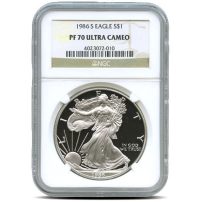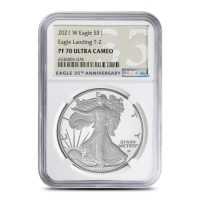






With more than 47 million coins sold in 2015 alone, the American Silver Eagle is the most popular coin in the world right now. Investors and collectors alike flock to this coin from the United States Mint because its metal content and purity are guaranteed by the federal government of the US. Introduced in 1986, the American Silver Eagle coin is available in a total of three different versions ranging from the bullion and proof (since 1986), and the burnished version of the coin (since 2006).
For those numismatists who love to collect silver coins, the Proof American Silver Eagle coin is an excellent cornerstone piece of any personal collection. The difference between bullion and proof coins is significant when it comes to the inherent value of the coin itself. All American Silver Eagle coins, regardless of style and finish, bear a face value of $1 (USD) issued by the United States government.
However, the Proof American Silver Eagle coin has a greater value than even its bullion counterpart. All versions of the coin have a value well beyond their face value, holding a value that is in line with the price of silver and based upon the purity and metal content of the coin. For the Proof American Silver Eagle, value can soar well beyond even the bullion version with certification from one of the nation’s, and world’s, two most respected certification companies.
The Numismatic Guaranty Corporation, or simply the NGC, is an American company that serves as one of the top third-party certification services. For rare coin collectors and proof coin collectors, a grade from the NGC can greatly enhance the value of their Proof NGC Certified American Silver Eagle coins.
The Numismatic Guaranty Corporation, or NGC for short, was founded in 1987 as a third-party coin grading service that is independent of any private or sovereign mint. Currently, the NGC employs 30 full-time coin certifiers who are prohibited by contract from buying or selling coins commercially to ensure they remain impartial graders of coins.
Prior to the formation of the Numismatic Guaranty Corporation (NGC), and its counterpart the Professional Coin Grading Service (PCGS), in the United States, the valuation and grading of historic and modern coins was very difficult. Physical condition of the coin is always used as the primary baseline in assessing the value of any collectible coin.
Dr. Willian Herbert Sheldon invented a rudimentary scale for grading coins in 1949. Early on, there were just three broad categories into which coins were classified, and these included the following:
However, it was quickly discovered that even two Fine coins could have subtle differences that weren’t enough to separate them to Good or Uncirculated. How was the world to determine the difference in value between two coins of Fine condition with minor differences? The Sheldon Numeric Scale grew to feature grades from 1 to 70, with 70 being the highest possible grade and representing a perfect specimen with no flaws.
Today, the Sheldon Scale is divided into three broad categories with room for enhancement based upon the specific certification number. For example, the scale now includes the following categories and positions on the grading scale:
The general purpose of the Sheldon Scale is to help differentiate between two of the same coin with slight variations in quality. Most of these variations are only spotted by trained professionals working for the PCGS, NGC, or other certification companies. The thought process involved in the grading scale, in a broad sense, dictates that a graded 70 coin is 70 times more valuable than one graded 1.
A full listing of NGC numeric grades is available here, but the most common Proof NGC Certified American Silver Eagle coins have the grades of PF 70 and PF 69. These grades identify coins as follows:
Additionally, the NGC uses a handful of other certification and designation terms for its NGC Certified American Silver Eagle coins that identify special visual characteristics or unique designations in production. These include the following:
When you see Proof NGC Certified American Silver Eagles in the JM Bullion catalog, you are viewing and considering for purchase coins that have gone through an extensive and highly regarding grading process. There is a general three-step process included in the NGC grading process, and are broken down into the following categories:
When the United States Mint introduced the American Silver Eagle coin in 1986, the mint dug into its archives to revitalize one of the nation’s most beloved images. Adolph A. Weinman was the artist and engraver behind the design known as Walking Liberty. Originally used on the Walking Liberty Half Dollar coin from 1916 to 1947, the image of Liberty features her full-length figure as she walks toward the setting sun with her right hand outstretched.
The Walking Liberty design is meant to depict the American drive to find a brighter future at all times. Liberty’s image is surrounded by engravings that include the word “”Liberty”” and the individual coins year of issue in the Proof American Silver Eagle coin series. Weinman’s image lives on to this day, and is considered by many to be the second greatest design ever behind only the Liberty image from Augustus Saint-Gaudens.
For the reverse side of the American Silver Eagle, the US Mint turned to Chief Engraver of the US Mint John Mercanti. He served in the role from 1986 until 2010 when he retired, and it was his job to modernize and revive the heraldic eagle of the United States. The design has been used by the US Mint since 1794, and Mercanti’s design has been fully modernized. The American bald eagle sits behind the nation’s heraldic shield. In its talons it clutches the arrows of war and the olive branch of peace. Above its head, 13 stars arranged in a triangular formation represent the original colonies of the US.
Since the American Silver Eagle was introduced in 1986, these images have remained unchanged on the obverse and reverse of the coins. All coins in the Silver Eagle program, including the Proof NGC Certified American Silver Eagle, feature these images.
As you browse our online catalog of Proof NGC Certified American Silver Eagle coins you’ll find that the date marks on these coins differ based upon the year of issue. When the American Silver Eagle program debuted in 1986, both bullion and proof coins were struck at the San Francisco Mint.
This remained the case for the Proof American Silver Eagle until 1992, at which point the production of the proof coins was shifted to the Philadelphia Mint from 1993 to 2000. Since 2001, Proof American Silver Eagle coins have been struck by the US Mint’s West Point Mint facility. The only year in which no proof versions of the coin were struck was 2009.
With the Great Recession taking hold in 2008 and global economies crashing, investors turned to the steadiness of silver and gold precious metals. This increased demand for the American Silver Eagle drove bullion coin demand through the roof and forced the US Mint to suspend the production of Proof American Silver Eagle coins. A shortage in the silver supply also contributed to the suspension of the proof series.
If you have any questions about the Certified Proof Silver Eagles, JM Bullion customer service is here to get you those answers. You can call us on the phone at 800-276-6508, chat with us live online, or simply send us an email with your inquiries. Our Payment Methods FAQ is also available to you to help answer simple questions regarding acceptable payment methods and applicable purchasing minimums.